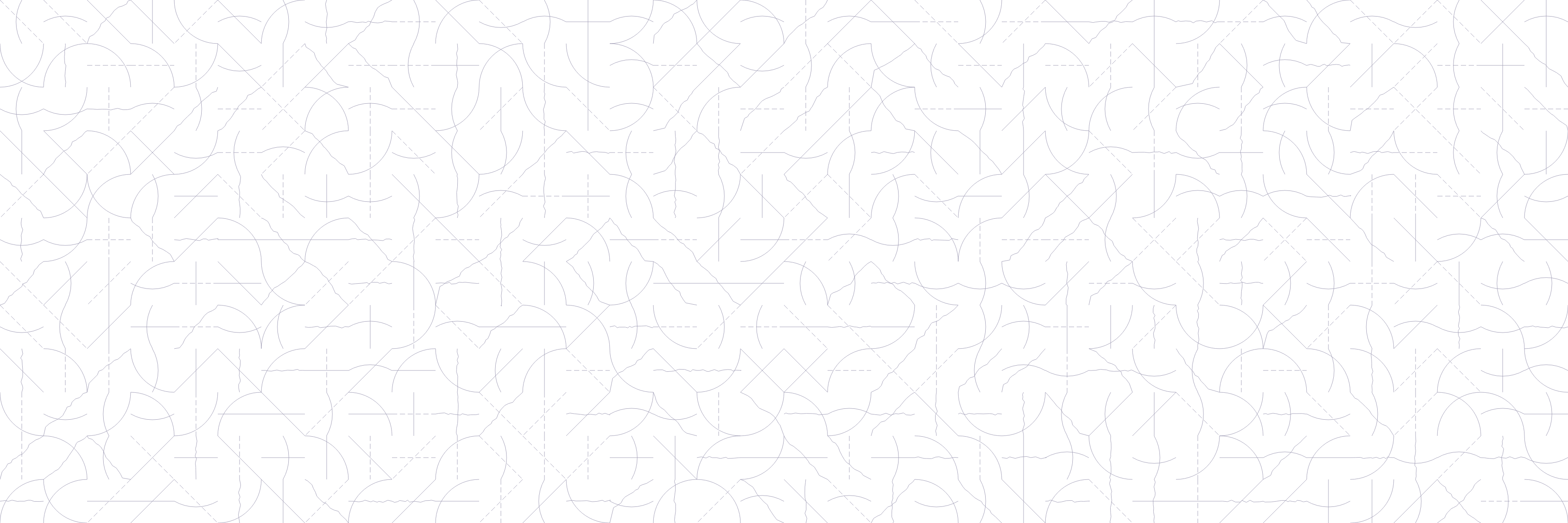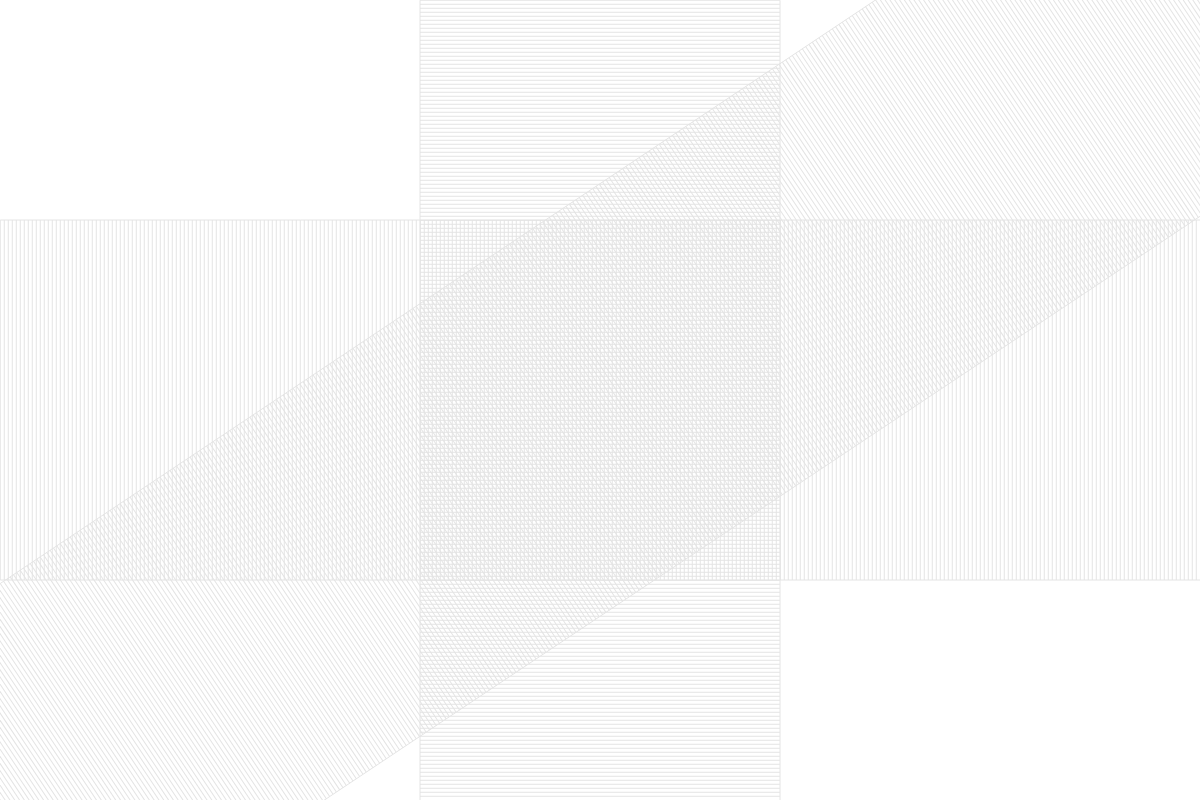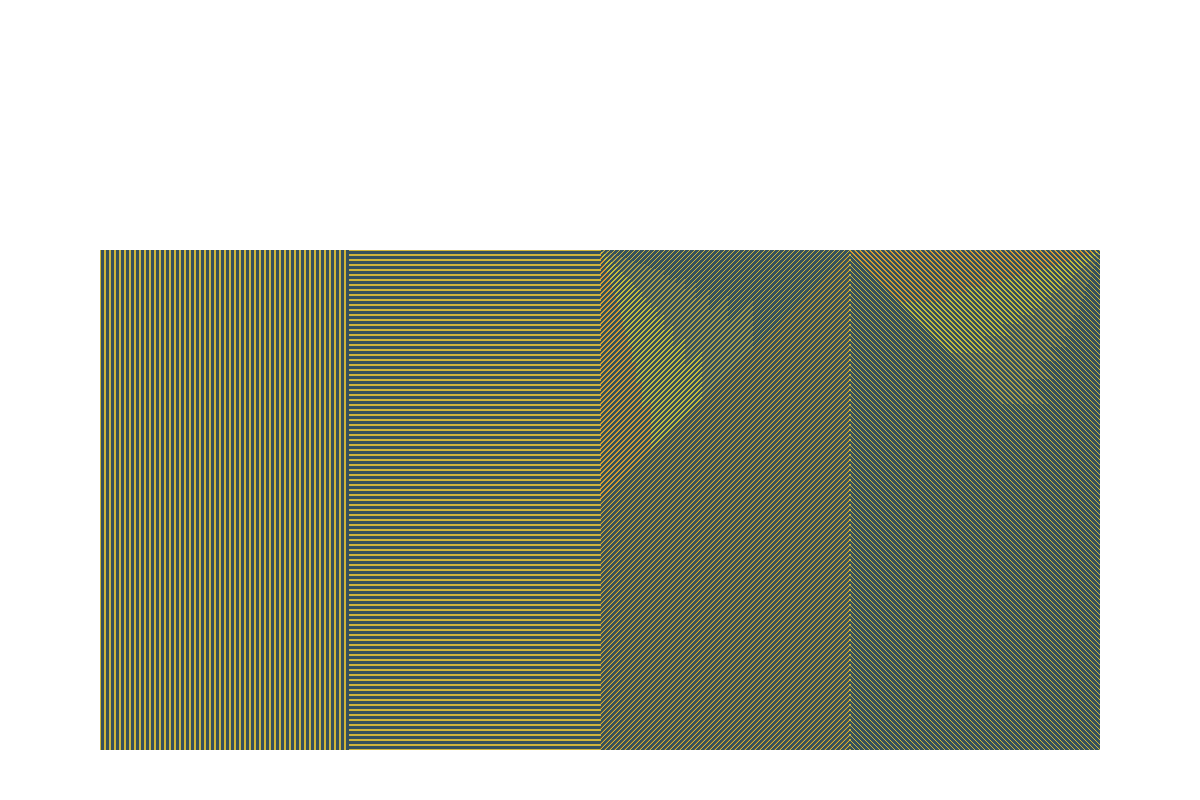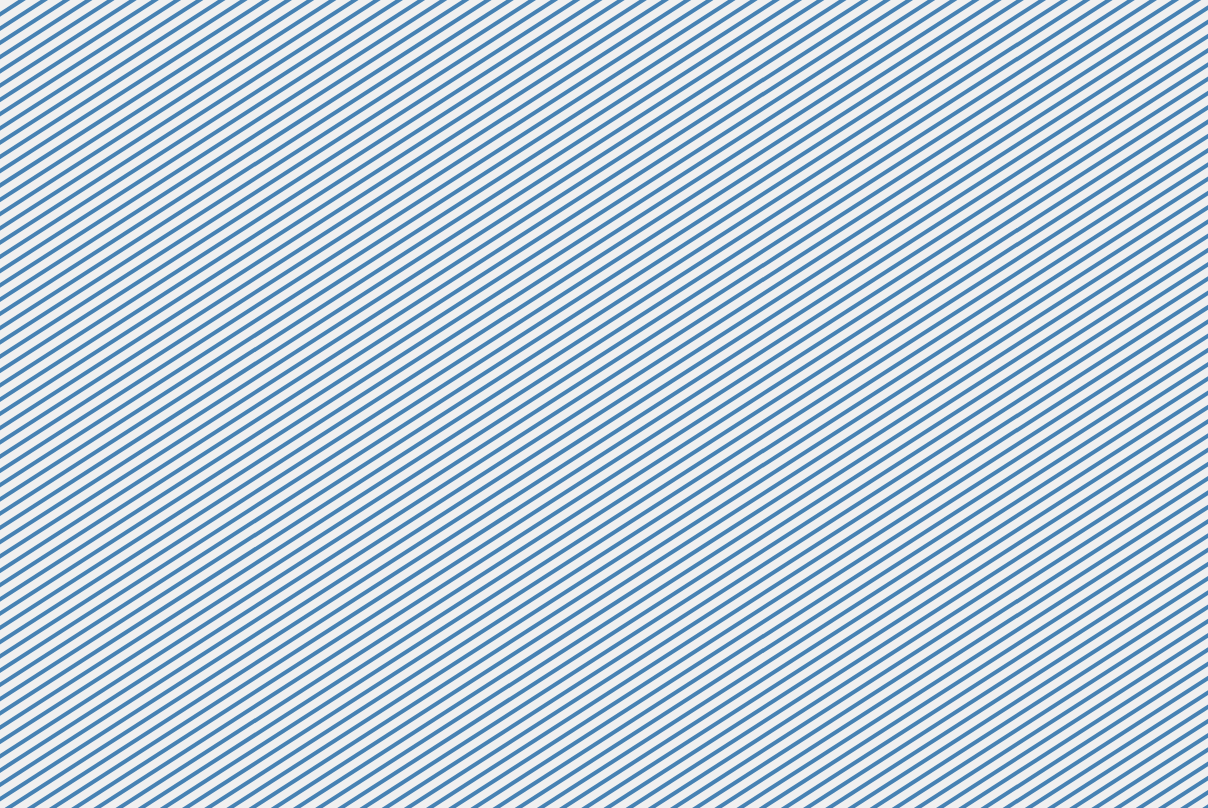Solving Sol
Wall Drawing #11 (1969)
A wall divided horizontally and vertically into four equal parts. Within each part, three of the four kinds of lines are superimposed.
Solutions by:
Wall Drawing #16 (1969)
Bands of lines 12 inches (30 cm) wide, in three directions (vertical, horizontal, diagonal right) intersecting.
Solutions by:
Wall Drawing #17 (1969)
Four-part drawing with a different line direction in each part.
Solutions by:
Wall Drawing #45 (1970)
Straight lines 10" (25 cm) long, not touching, covering the wall evenly.
Solutions by:
Wall Drawing #46 (1970)
Vertical lines, not straight, not touching, covering the wall evenly.
Solutions by:
Wall Drawing #49 (1970)
A wall divided equally into fifteen equal parts, each with a different line direction and color, and all combinations.
Red, Yellow, Blue, Black pencil

Solutions by:
Wall Drawing #51 (1970)
All architectural points connected by straight lines.
Blue snap lines
Solutions by:
Wall Drawing #56 (1970)
A square is divided horizontally and vertically into four equal parts, each with lines in four directions superimposed progressively.
Solutions by:
Wall Drawing #65 (1971)
Lines not short, not straight, crossing and touching, drawn at random, using four colors, uniformly dispersed with maximum density, covering the entire surface of the wall.
Solutions by:
Wall Drawing #85 (1971)
A wall is divided into four horizontal parts. In the top row are four equal divisions, each with lines in a different direction. In the second row, six double combinations; in the third row, four triple combinations; in the bottom row, all four combinations superimposed.
Solutions by:
Wall Drawing #86 (1971)
Ten thousand lines about 10 inches (25 cm) long, covering the wall evenly.
Solutions by:
Wall Drawing #87 (1971)
A square divided horizontally and vertically into four equal parts, each with lines and colors in four directions superimposed progressively.
Solutions by:
Wall Drawing #88 (1971)
A 6-inch (15 cm) grid covering the wall. Within each square, not straight lines in either of four directions. Only one direction in each square but as many as desired, and at least one line in each square.
Solutions by:
Wall Drawing #91 (1971)
A six-inch (15 cm) grid covering the wall. Within each square, not straight lines from side to side, using red, yellow and blue pencils. Each square contains at least one line of each color.
Solutions by:
Wall Drawing #97 (1971)
Within an 80 inch (200cm) square, 10,000 straight lines. Next to it is an 80 inch (200 cm) square with 10,000 not straight lines.
Solutions by:
Wall Drawing #118 (1971)
On a wall surface, any continuous stretch of wall, using a hard pencil, place fifty points at random. The points should be evenly distributed over the area of the wall. All of the points should be connected by straight lines.
Solutions by:
Wall Drawing #122 (1972)
All combinations of two lines crossing, placed at random, using arcs from corners and sides, straight, not straight and broken lines.
Solutions by:
Wall Drawing #146 (1972)
All two-part combinations of blue arcs from corners and sides, and blue straight, not straight, and broken lines.
Solutions by:
Wall Drawing #164 (1973)
A black outlined square with a red horizontal line centered on the axis between the midpoint of the left side and the midpoint of the right side and a red diagonal line centered on the axis between the lower left and upper right corners.
Solutions by:
Wall Drawing #273 (1975)
Lines to points on a grid. A six-inch (15 cm) grid covering the wall. Lines from the corners, sides, and center of the walls to random points on the grid. Composite (seventh wall): red lines from the midpoints of four sides, blue lines from four corners, yellow lines from the center.
Solutions by:
Wall Drawing #289 (1976)
A six-inch (15cm) grid covering each of the four black walls. White lines to points on the grid. 1st wall: 24 lines from the center; 2nd wall: 12 lines from the midpoint of each of the sides; 3rd wall: 12 lines from each corner; 4th wall: 24 lines from the center, 12 lines from the midpoint of each of the sides, 12 lines from each corner.
Solutions by:
Wall Drawing #295 (1976)
Six white geometric figures (outlines) superimposed on a black wall.
Solutions by:
Wall Drawing #328 (1980)
On a black wall, a white circle within which are white vertical parallel lines, and a white parallelogram within which are white horizontal parallel lines. The vertical lines within the circle do not enter the parallelogram, and the horizontal lines within the parallelogram do not enter the circle.
Solutions by:
Wall Drawing #335 (1980)
On four black walls, white vertical parallel lines, and in the center of the walls, eight geometric figures (including cross, X) within which are white horizontal parallel lines. The vertical lines do not enter the figures.
Solutions by:
Wall Drawing #340 (1980)
Six-part drawing. The wall is divided horizontally and vertically into six equal parts. 1st part: On red, blue horizontal parallel lines, and in the center, a circle within which are yellow vertical parallel lines; 2nd part: On yellow, red horizontal parallel lines, and in the center, a square within which are blue vertical parallel lines; 3rd part: On blue, yellow horizontal parallel lines, and in the center, a triangle within which are red vertical parallel lines; 4th part: On red, yellow horizontal parallel lines, and in the center, a rectangle within which are blue vertical parallel lines; 5th part: On yellow, blue horizontal parallel lines, and in the center, a trapezoid within which are red vertical parallel lines; 6th part: On blue, red horizontal parallel lines, and in the center, a parallelogram within which are yellow vertical parallel lines. The horizontal lines do not enter the figures.
Solutions by:
Wall Drawing #349 (1981)
Ten geometric figures in black india ink on walls painted red, yellow, blue, white.
Solutions by:
Wall Drawing #391 (1983)
Two-part drawing. The two walls are each divided horizontally and vertically into four equal parts. First wall: 12-inch (30 cm) bands of lines in four directions, one direction in each part, drawn in black India ink. Second wall: Same, but with four colors drawn in India ink and color ink washes.
Solutions by:
Wall Drawing #392 (1983)
A 12" (30 cm) grid covering the black wall. Within each 12" (30 cm) square, a vertical, horizontal, diagonal right or diagonal left line bisecting the square. All squares are filled. (The direction of the line in each square is determined by the drafter)
Solutions by:
Wall Drawing 396 (1983)
A black five-pointed star, a yellow six-pointed star, a red seven-pointed star, and a blue eight-pointed star, drawn in color and India ink washes.
Solutions by:
Wall Drawing #579 (1988)
Three concentric arches. The outside one is blue; the middle red; and the inside one is yellow.
Solutions by:
Wall Drawing #614 (1989)
Rectangles formed by 3-inch (8 cm) wide India ink bands, meeting at right angles.
Solutions by:
Wall Drawing #630 (1990)
A wall is divided horizontally into two equal parts. Top: alternating horizontal black and white 8-inch (20 cm) bands. Bottom: alternating vertical black and white 8-inch (20 cm) bands.
Solutions by:
Wall Drawing #766 (1994)
Twenty-one isometric cubes of varying sizes, each with color ink washes superimposed.
Solutions by:
Wall Drawing #797 (1995)
The first drafter has a black marker and makes an irregular horizontal line near the top of the wall. Then the second drafter tries to copy it (without touching it) using a red marker. The third drafter does the same, using a yellow marker. The fourth drafter does the same using a blue marker. Then the second drafter followed by the third and fourth copies the last line drawn until the bottom of the wall is reached.
Solutions by:
Wall Drawing #852 (1998)
A wall divided from the upper left to the lower right by a curvy line; left: glossy yellow; right: glossy purple.
Solutions by:
Wall Drawing #853 (1998)
A wall bordered and divided vertically into two parts by a flat black band. Left part: a square is divided vertically by a curvy line. Left: glossy red; right: glossy green; Right part: a square is divided horizontally by a curvy line. Top: glossy blue; bottom: glossy orange.
Solutions by:
Wall Drawing #1136 (2004)
The actual letter of instruction is unavailable, but the Tate <a href="http://www.tate.org.uk/art/artworks/lewitt-wall-drawing-1136-ar00165/text-summary">provides</a> this information:
The work is composed of both curved and straight solid bands of colour that are painted directly onto the surface of a wall using every primary (red, yellow, blue) and secondary (green, orange, purple) colour plus grey. The curve, made up of nine interlocking bands in these seven colours (there are two bands each of red and green), snakes along the wall, touching the top and bottom of the wall at various points. The same seven colours reappear, in an irregular sequence, as vertical bands that serve as a background pattern for the curve. Every band in the wall drawing is of the same width and there is no area left empty of colour.
Vertical lines of equal width cover the wall, in this order:
GYBOP ERBYG ERPGY BOERB GYPOB GRPEY BGOPY BERPO GBYPR EOGYB OERPB YOPGE BRYBE OPRGB EYRGP OBRGO YEBRG OPYBE RGORB EYBOP GRBPE YBRPE OGBYE PORGE BPYRG OPEYG POREB YPGBR OGYBR
On top of the vertical lines is a curve, with colors top to bottom: POGREBGR
G Green Y Yellow B Blue O Orange P Purple E Grey R Red
Solutions by:
Wall Drawing #1180 (2005)
Within a circle, draw 10,000 black straight lines and 10,000 black not straight lines. All lines are randomly spaced and equally distributed.




